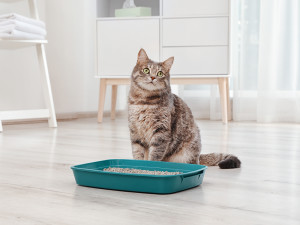Toxoplasmosis in Cats Can Be a Big Deal
Scoop cat poo early and often – and keep their poo away from your garden

Share Article
If you’re the kind of person who Googles, ‘My cat is sick; can I catch it?’ every single time your cat looks even a little vommyopens in a new tab, you’re going to want to read on. There are a handful of diseases that you can catch from a cat, usually from infected faeces, infected skin or bites and scratches. One of the most commonly discussed is toxoplasmosis, one of the poo-related diseases.
This disease was once considered so worrisome that physicians would recommend that pregnant people rehome their cats. The NHS now recommendsopens in a new tab that you just take general precautions instead. Let’s review what toxoplasmosis is, how cats get it, how people get it, and how to avoid getting it without getting rid of your cat.

littleKin™ is Kinship’s home just for puppy and kitten parents. Bop over to check out expert advice, new pet tools, and special deals—all curated for your newest family member.
opens in a new tabWhat is toxoplasmosis and how do cats get it?
Toxoplasmosis is an infection caused by microscopic protozoa – single-celled organisms – called Toxoplasma gondii. Toxoplasmosis can affect mammals, including humans and is of particular concern in households with cats.
Cats are the definitive hosts for Toxoplasma gondii, meaning they are the only species in which the parasite can sexually reproduce. Cats become infected by ingesting birds, small mammals or raw/undercooked meat infected with tissue cysts. The parasite completes part of the reproductive process within the cat, then the cat sheds oocysts (thick-walled cells that contain fertilised eggs) in their faeces. These oocysts contaminate the environment where the cat poos – soil, water or litter boxopens in a new tab – and become infective after one to five days.
Animals in the environment, often birds, small mammals or livestock, become infected by ingesting the oocysts from contaminated soil or water. The oocysts will burst open within these animals and form cysts in their muscle tissue, restarting the cycle.
What are the symptoms of toxoplasmosis in cats?
Healthy adult cats may have a short bout of diarrhoeaopens in a new tab at worst, but most cats infected with Toxoplasma gondii don’t show any symptoms. Young kittens and cats with compromised immune systems have a greater risk of developing clinical signs associated with the parasite dividing and migrating through the body.
Young kittens with toxoplasmosis will display a general failure to thrive known as ‘fading kitten syndrome‘. These kittens are often born underweight and have difficulty feeding and maintaining normal body temperatures. Without (and sometimes despite) significant nursing care, they often don’t survive. Toxoplasmosis symptoms seen in cats of all ages can include:
lethargy
fever
vomiting and diarrhoeaopens in a new tab
jaundice (yellowing of the skin or eyes)
uveitis (inflammation within the eye)
blindness
neurological signs (including seizures, trouble walking, behaviour changes, paralysis)
pneumonia
miscarriage or stillbirth in pregnant cats
How do you diagnose toxoplasmosis in cats?
Because most cats do not show any symptoms of infection, many Toxoplasma infections go undetected. Even when infection is suspected, confirmation can be difficult. Usually, a combination of medical history, clinical signs, blood work, and response to treatment are used to make a diagnosis. Antibody levels may be measured to determine likelihood of current disease, previous exposure or risk of future exposure.
How do you treat toxoplasmosis in cats?
Antibiotics are the primary treatment for toxoplasmosis in cats. In addition to antibiotics, your vet may recommend secondary treatments to address inflammation in the eyes or central nervous system. Depending on the severity of disease, supportive care may be required to address dehydrationopens in a new tab, anorexia, nausea or discomfort.
With appropriate treatment, most cats show noticeable improvement within 72 hours. Prognosis is worse in young kittens, immunocompromised cats, and cats that develop neurologic symptoms. Even if a cat’s symptoms resolve, medication cannot fully eliminate the organism from the tissues. This means that recurrence is possible, though rare.
The solution: scoop the poop early and often
All humans are at risk for being infected by Toxoplasma gondii. Similar to cats, people with healthy immune systems typically don’t have any symptoms. Humans can get infected through contact with infected cat faeces, by ingesting undercooked and infected meat, by drinking infected water, in utero, and (very rarely) through transfusions and transplants.
Let’s focus on the cat crap for a minute. Because cats infected with Toxoplasma gondii will shed oocytes in their faeces, anyone who handles cat faecesopens in a new tab is at risk for exposure. The most obvious point of contact is the litter box. A less commonly considered exposure is gardening or consuming home-grown produce if neighbourhood cats use the garden as a litter box. Cats may also use playground sandpits as giant litter boxes, creating a point of exposure for children.
Becoming infected with Toxoplasma gondii during pregnancy carries the risk of passing the parasite on to the foetus, which can result in a condition called congenital toxoplasmosis. Congenital toxoplasmosis can result in blindness, neurological disease, mental disorders or stillbirth. People infected with Toxoplasma while pregnant may experience flu-like symptoms or no symptoms at all.
People can also take multiple precautions to avoid getting Toxoplasma from cats, especially those who are pregnant or immune-compromised. People who enjoy gardening and garden-fresh produce should wear gloves while gardening and wash their hands afterward. The produce should also be carefully washed. Because it takes at least 24 hours for the oocysts in cat faeces to become infective, litter boxesopens in a new tab should be cleaned daily to minimise risk. If possible, those who are pregnant or immune-compromised should avoid litter box duties completely.
You can protect your cat from Toxoplasma by feeding a cooked, commercial diet. If you cat is an indoor cat, this will prevent them from hunting small prey animals like birds and rodents that may have infected tissue cysts.
People who are pregnant should visit Tommy’s for further information on toxoplasmosisopens in a new tab.

Dr. Alycia Washington, DVM, MS
Alycia Washington, DVM, is a small animal emergency veterinarian based in North Carolina. She works as a relief veterinarianopens in a new tab and provides services to numerous emergency and specialty hospitals. Dr. Washington is also a children’s book author and freelance writer with a focus on veterinary medicine. She has a special fondness for turtles, honey bees, and penguins — none of which she treats. In her free time, Dr. Washington enjoys travel, good food, and good enough coffee.
Related articles
 opens in a new tab
opens in a new tabUncovered Secrets: Why Cats Don’t Always Cover Their Poo
And how you can encourage them to cover up after doing their business
 opens in a new tab
opens in a new tabWhy Is Your Cat Vomiting Like They Partied All Night?
Here’s when you should worry if your cat is throwing up
 opens in a new tab
opens in a new tabStep-by-Step Guide: How to Safely Express Your Cat’s Anal Glands At Home
Ick. It won’t be fun, but here’s how to get the job done
 opens in a new tab
opens in a new tabIs Your Cat Full of Sh*t?
Seriously, though – here’s how to deal with cat constipation
 opens in a new tab
opens in a new tabWhat to Know About Tapeworms in Cats
What to look for and how to treat it (to be able to eat rice again)
 opens in a new tab
opens in a new tabDo Cats Fart?
Causes and remedies for cat flatulence


